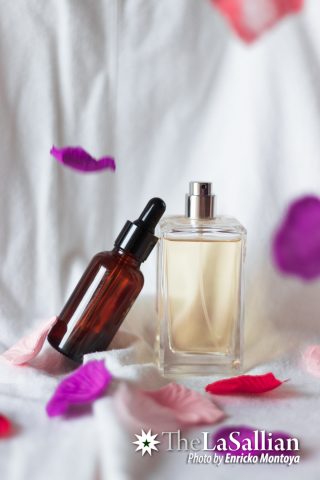The ennui brought by the COVID-19 pandemic has pushed us into a deep state of yearning. As we dream of a blissful life outdoors, many resort to movies and music to temporarily quell their longing. However, some prefer a subtle yet vibrant medium to destress—scents.
Like a puppet on a string, our emotions and memories are evoked by the power of aroma—reminding people of certain dishes, a certain person, or a certain incident. For a brief moment, we defy time; what’s gone is in our grasp again. While paintings and symphonies have long inspired similar artistic and heartfelt expressions, the appeal toward olfaction may not be easily perceived by everyone.
As multibillion fragrance brands like Chanel and Jo Malone invigorate the world with their scents, the local olfactory art scene is slowly emerging to carve a place of its own.

Two cents on scents
Filipino perfumer Oscar Mejia III started as a kid playing with flowers from his parents’ farm. “I would pick flowers, boil them, and create my perfume,” he recollects. While he later found out that this was not the correct method of extracting the scent, it did spark his fascination with fragrances. Soon after, his curiosity blossomed into a passion for scent-making.
But Mejia reveals, “It’s not common knowledge [that] we used to have a particular place in the global perfume industry.” For decades, workers churned out quality perfume oils for European fragrance houses, most notably the ylang-ylang oil found in the early versions of the infamous Chanel No. 5 in the 1920s.
With that, Mejia saw it as his mission to further elevate the country’s fragrance industry. “[It’s] not common for anyone because well, apart from it’s not really [the] interest [of people], it’s difficult [work],” he expresses.
But beyond perfumery, other scented products are even more niche. Nicole Cabugos, owner of scented candle shop Salamangka Atbp., started as an avid collector of scented items like body butters, essential oils, and candles. “My friends would always say na, ‘Very tita naman. You would always light a candle. Meron kang humidifier [pati] diffuser,’” she fondly recounts.
(You’re like an auntie. You would always light a candle. You even own a humidifier and a diffuser. )
Soon enough, Cabugos took her love for scented candles further by crafting her own during the pandemic. Initially created as gifts to family and friends, it soon escalated into a business venture. Cabugos’ Salamangka candles became her source of solace and creativity, taking pride in every work she crafts.
Noses at work
The journey of a thousand sniffs begins with a concept that appeals to our sensibilities. Grasse-trained perfumer Renato Lopena Jr. emphasizes the importance of delivering a scent with a compelling story. He confers with his clients on the specific fragrance notes they want “[because] those are the notes [they] have an emotional connection [with].”
Lopena carefully selects the appropriate scent notes from hundreds of raw materials to orchestrate the perfume’s composition properly. After going back and forth with revisions to create the perfect scent, the real work begins. This entails capturing a certain feeling and translating that into an unforgettable and distinct fragrance.
Similarly, Mejia shares an even more memorable experience working on a bespoke scent for a client. “She wanted to have a scent that would remind her of her mom [who passed away],” he says. With that, he crafted a scent that reflected the aroma of baking and gardening, which were the hobbies of the client’s mom. He notes that olfactory art is a deeply immersive process that is “more a work of the heart.”
But as he observes, Filipinos are particularly fond of scents that greet the nose lightly. “Every time someone comes to me for a bespoke scent, they always say… ”yung maaliwalas, ‘yung amoy bagong ligo, ‘yung amoy fresh laundry’,” he explains. This led him to build a fragrance portfolio that ranges from floral to woodsy notes—easy on the nose, the mark of a Filipino scent.
(They always say they want to have crisp scents that smell like fresh laundry.)
This penchant for fresh scents resonates with Cabugos as well. Out of over 20 skillfully crafted candles, her favorite scent would be the mellow, tropical blend of bamboo and coconut named Kalinaw. “The scents [of] bamboo and coconut have a unique quality to it [as] it is very fragrant but [does not] hurt your nose,” she describes.
Ultimately, Cabugos realizes, “Kahit na pare-pareho ng method [and raw materials], iba-iba [‘yung] atake. So it’s a form of self-expression din kung paano mo ible-blend ‘yung mga [scents].”
(Even though the methods and raw materials are the same, each approach is different. So it’s a form of self-expression with how you blend the scents.)
Work of the heart
Lopena observes that art appealing to a person’s olfaction transcends time and place; it makes a person’s distant memories feel tangible all of a sudden. Mejia concurs, reminiscing about pre-pandemic art fairs where he talked to people about their experiences with particular scents. “Their stories are very much different,” he points out.
Today, the Philippines has the third largest market for perfumes in Southeast Asia. But despite the country’s rich resources for fragrance oils, the lack of facilities and equipment for production threatens our scent-making industry. However, the emergence of scented products in the market brings hope to olfactory artists like Mejia, Cabugos, and Lopena. “Meron pa ‘yung iba, they’re trying to revive this ylang-ylang extraction [facility] in Nueva Ecija,” Mejia shares, hoping for a farm-to-bottle method of fragrance production in the future.
Although there has yet to be a compelling space for olfactory art in the economy, exploring the artistic medium of olfaction already promises a bigger room for Filipinos to create and express themselves. “Go out, explore the world through your nose,” Mejia encourages.
